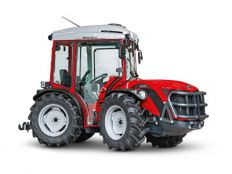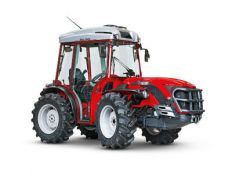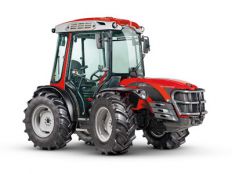ArlyA
Super Star Member
- Joined
- Mar 18, 2016
- Messages
- 13,356
- Tractor
- Outlander1000 6x6, Ego lawn mower and shopping for tractor
HST work best for some some jobs while a manual tranny works best for others. What's the argument?
Actually, the 2xx series is in the 8000 lbs range. It's weight sure is more pointed to ground engaging work vs surface maintenance that you do.Dont want, nor do I need a 80hp 9000 pound machine.
Yes, you can get CVT's, IVT's, KVT's whatever. And yes their operation is very similar to HST. still have a forward and reverse selector but pedal intuition is gonna be about the same.
The problem is those all come on tractors WAY bigger than I want.
One size up from a MX or 4000-series deere is what I am after. Not 3 sizes up.
A simple 5000# tractor with 20 or 24" fronts, not the 16" wheels.
Like I said....M6060 or M7060 kubota or a 5065/5075 deere would be perfect. But a tractor that size is not offered in any type of variable transmission or HST. Only banging gears and shuttle. But I dont sit and browse the dozens of tractor MFG's so for all I knew someone already had an offering or something in the pipeline. But that dont seem to be the case thus far
Wondering what everyone's thoughts are and if there would be demand for bigger HST machines? ...
I use a Antonio Carraro HST 9800 (85 hp) with a Cleanfix radiator cleaner. Mowing hilly property with a 5' flail mower. Not cheap, but does the work.



unless the grass density is highly variasble, in which case variable speed can actually improve productivity: speed up where the mowing is easy, slow down for the tough spots.
HST for loader/grapple work, but for field work go Gears.
I'm in the same boat as you. Own/operate a 150 acre tree farm family property 50% wooded with CRP fields to mow, various hazards and obstacles to mow/operate around, deer plots to roto-till, trees to work around. Biggest and most powerful modern HST tractor I can find is a Deere 4066. But a Deere 5075 with HST would be absolutely perfect.
Got multiple family members who run the tractors with varying levels of expertise. So the HST just works well and is easiest to use. It's safer for some of the steep downhill parts of our property where you just let off the pedal and creep down.
Between our Ford 1920 and TC40, I'll choose the TC40 to mow with every single time. Being able to just let off the pedal to blend up a thicker patch of tall grass or debris, then reverse and back over again is just so much easier with the HST. Same with roto-tilling....on the 1920 I've got to constantly mess with the 3-pt height if it starts to bog down, on the TC40 I just let off the pedal and go a bit slower until it pulls through.
I for one would absolutely be interested in a 5075 or equivalent with an HST.
Maybe? I looked them up this morning but now I aint seeing anything smaller than 300 series on their site. But what I saw this morning listed a 207 @ ~4150KG.... which is a tad over 9kActually, the 2xx series is in the 8000 lbs range. It's weight sure is more pointed to ground engaging work vs surface maintenance that you do.
But HSTs are definitely available above the 60 hp threshold.
HP isnt really the concern. Sure a little more would certainly be put to use. But the idea of the bigger frame is mainly for the smoother ride offered by having 20's or 24's up front. Top that off with a little more ground clearance and sitting higher (better visibility). Thats what I am after. Not necessarily more power.What about just boosting the HP on the MX a little bit and not trading it for something bigger?
Your explanation about the size of pumps and and the resulting changes in design makes a few things clearer for me now.I assume that the companies do a lot of market analysis before deciding. My last 2 companies prior to retiring, CNH and Caterpillar, surveyed to death but often missed the customer. They surveyed big operators and large dealers for the most part. I was in engineering, then switched to product support, and got to talk to the people in the trenches so to speak. My input was accepted for improving durability and maintenance, but things like that talked about here --- very little. That would make it too expensive to sell in its power range would be the likely marketing response - but marketing can sell anything if it's cheap.
But one of the problems faced is suppliers as the companies buy their hydros from somebody else. I selected Bosch-Rexroth as one of the most important suppliers worldwide. A very popular size hydro pump is 56cc max displacement. The next size is 71cc. The 56cc may be good to 60 hp, but the next step to the 71 cc might double the price of the transmission. So that is why we see tractors stopping at about 60 hp. One of my products at Cat doubled - 2 56cc pumps instead of a larger pump in part for reduced height and width but also because we could mount 2 smaller ones at less cost than one large one. So one drove the front, one drove the rear. But we are talking about a machine that cost over $200k. That's all a bunch of engineering jargon but what I am getting at is that due to hydro pump and motor sizing, the jump from 60 to 75 hp might increase the cost of the tractor 25% and wouldn't be marketable.
I work in the same fields with my BIL and nephew driving old fully gear driven IH tractors. We can measure in loads produced every day and I always beat them because of no shifting. Windrow gets heavy, I back off with my KVT control lever. They need to stop and shift down, then stop and shift up. Beyond making hay, the same thing follows in tillage. They don't stop to shift - they go at the slower speed all the time while l set the power and my KVT adjusts to maintain that % of max power all the time, slows for tough going, speeds up in easy going. Much more efficient. Fuel efficiency - I am always running where my engine is most fuel efficient in gm/kW-hr. They seldom hit their engine's sweet spot. Full power shifts get darn close to a CVT, especially when you get over 20 speeds. However my cousin's JD's really have 4 power shift speeds on a so called 20 speed power shift transmission. Power sift is between those 4 speeds. Next is stop and shift range to get a different 4 speed power shift. His NH is better, 6 in each of 4 ranges but there still is the range shift that isn't power.
To the OP - find a nice used IH Hydro-100 or Hydro-186. Rare, but tough and get the job done.